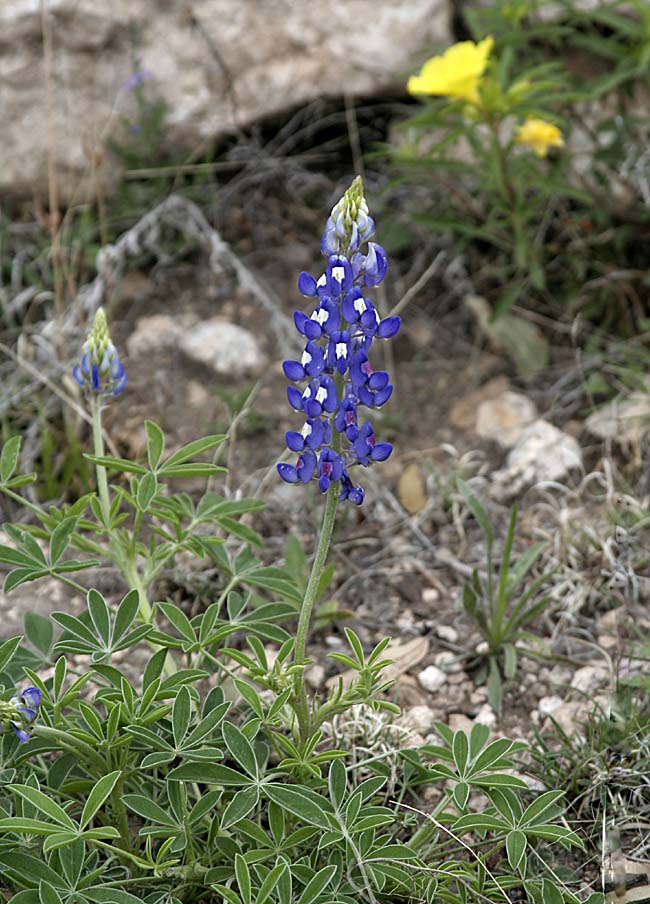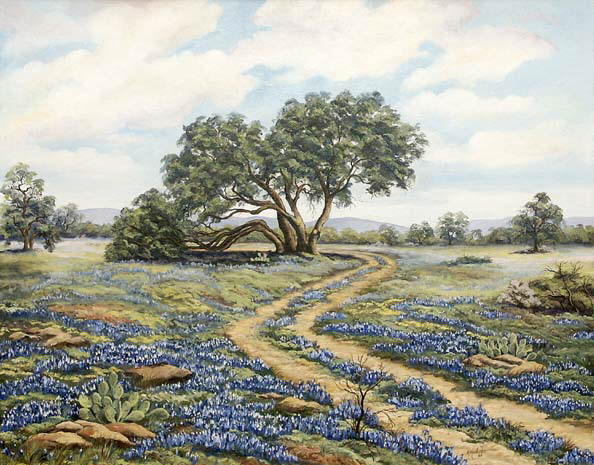Bluebonnet
![]()
This Site:
The State Flower of Texas; The Bluebonnet
Above we show a picture of the Bluebonnet, the State Flower of Texas. The proper name for the species is Lupinus texensis. A typical plant is about 8 inches tall, and the colored part of a bloom is about 4 inches tall. Notice that each stem has 5 leaves, representing the five points of the Texas Lone Star. The plants grow during the winter, and then bloom around the last week of March to the first few weeks of April. Bluebonnets are native to Texas, and grow wild with no attention or care required.
When conditions are right, entire fields turn blue from the dense growth of this beautiful flower. The best bluebonnet seasons occur occur after winters that are very cold and very wet. Interestingly, the more miserable the winter, the more beautiful the spring. Since the bluebonnet plants grow all winter, it is the winter rains that are really needed to have beautiful blooms in springtime. In addition, very cold conditions help the seeds germinate, so winters with extended periods of cold will yield the densest growths of bluebonnets. Sheep and goats will eat the bluebonnets, so for a field to be decorated in blue, there needs to be no sheep or goats grazing on the land.
This majestic scene of rolling hills painted blue by these wonderful flowers has become a trademark of springtime in the Texas Hill Country. The area in the triangle formed by Austin, San Antonio, and San Angelo is the region where the most beautiful blooms of bluebonnets can be found. Fredericksburg, Junction, Christoval, Kerrville, San Marcus, and Mason, Texas are small towns that come alive with fields of bluebonnets. Driving through these areas the first week of April is well worth the trip.
Famous Bluebonnet Painting by Rita McWhorter
Scenes of Bluebonnets in bloom are a favorite subject for artists and photographers across Texas. The painting above is an excellent representation of a spring scene when the bluebonnets are in full bloom. The painting was hung in the United States capitol as a tribute to this spectacular flower.
Bluebonnet History
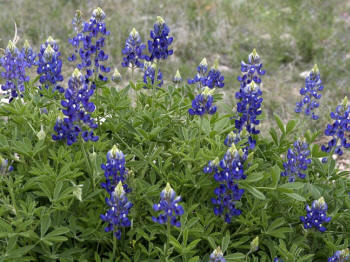 About
1900, Texas decided that it needed an official state flower. This was a
pretty serious matter, and lots of detailed debate occurred as to what
flower was suitable to represent a state as large and grand as Texas.
There was a lot of support for the Cotton Boll. Not necessarily because
it was beautiful, but because it was a source of wealth and prosperity
in the state. After all, everyone knew that “Cotton was King” in Texas,
and across the south. John Nance Garner, who later became the Speaker
of the United States House of Representatives (1931), and then the 32nd
Vice President of the United States, was a staunch advocate of the
Prickly Pear bloom. It is unclear why he was so adamant in his support
of a plant that had no economic value (in fact it was a nuisance), and
little aesthetic appeal. Nonetheless, his steadfast debate in support of
the prickly pear earned him the nickname “Cactus Jack” Garner. This
sobriquet stuck, and remained with him the remainder of his life. John
Green then suggested the bluebonnet as the state flower, as it was
native to the state, did not grow in other places, and was beautiful.
This flower was as beautiful and unique as the state itself, and quickly
gained lots of popular support. An influential women's group of the day
threw their support behind the bluebonnet. The growing support for this
choice became known as the “Bluebonnet War”. Finally, the legislature
selected the bluebonnet, and on March 7, 1901 the bill making the
bluebonnet the official state flower was signed by Governor Joseph
Sayers.
About
1900, Texas decided that it needed an official state flower. This was a
pretty serious matter, and lots of detailed debate occurred as to what
flower was suitable to represent a state as large and grand as Texas.
There was a lot of support for the Cotton Boll. Not necessarily because
it was beautiful, but because it was a source of wealth and prosperity
in the state. After all, everyone knew that “Cotton was King” in Texas,
and across the south. John Nance Garner, who later became the Speaker
of the United States House of Representatives (1931), and then the 32nd
Vice President of the United States, was a staunch advocate of the
Prickly Pear bloom. It is unclear why he was so adamant in his support
of a plant that had no economic value (in fact it was a nuisance), and
little aesthetic appeal. Nonetheless, his steadfast debate in support of
the prickly pear earned him the nickname “Cactus Jack” Garner. This
sobriquet stuck, and remained with him the remainder of his life. John
Green then suggested the bluebonnet as the state flower, as it was
native to the state, did not grow in other places, and was beautiful.
This flower was as beautiful and unique as the state itself, and quickly
gained lots of popular support. An influential women's group of the day
threw their support behind the bluebonnet. The growing support for this
choice became known as the “Bluebonnet War”. Finally, the legislature
selected the bluebonnet, and on March 7, 1901 the bill making the
bluebonnet the official state flower was signed by Governor Joseph
Sayers.
Growing Bluebonnets
If you are lucky enough to live in Central Texas, then you probably already enjoy the bluebonnets that grow naturally in the area. If you are not fortunate enough to live in Central Texas, then by all means, move here (just kidding). Seriously though, whether you live in an area where bluebonnets are native or not, there are things you can do to get them started, and if you already have them, things you can do to get more impressive bluebonnet patches.
We have several suggestions to help you get your bluebonnet patch going. First, the best way to get things started is by buying seeds, not seedlings. Seedlings are too expensive, and you will want a big patch, so go with seeds. Bluebonnet seeds have a very hard covering, and are very hard to get to germinate. Chances are that only about 10% of natural seeds will germinate in any given year. This actually makes the species very resilient. Even if there are several years of drought, there will be seeds from previous years that did not germinate, waiting for a good wet year. But, if you want to get a patch going strong the first year you plant, you will want to make sure you are buying scarified seeds. These seeds are chemically treated in order to get more of them to germinate. Scarified seeds are available from most seed catalogs.
Bluebonnets like well drained soil. They do not do so well in heavy clay soil. Bluebonnets like full, direct sunlight. Plant them where they will get the maximum sun possible.
Bluebonnets sprout in the fall, and then grow all winter long. As such, you will want to plant them in the fall. September or October are the best times to put the seeds out. The seeds should be planted about 1/8 inch deep. If you are planting a large area, you can spread the seed, and then rake them into the ground. If you leave them on the surface, they will get eaten by birds.
Now, if you really want to ensure that you have a spectacular patch of bluebonnets in the spring, you can do two things. First, water the patch during the winter. Since the plants themselves grow during the winter, the more winter water they receive, the more impressive the springtime blooms will be. Second thing, you will want to keep the pesky goats and sheep out of you patch. Goats and sheep would prefer to eat the tender green bluebonnet sprouts than the old dry winter grass. In years with lots of winter rain, you will not need to water, but if you are having a dry winter, a little bit of extra water can make a big difference come springtime.
More Bluebonnet Pictures
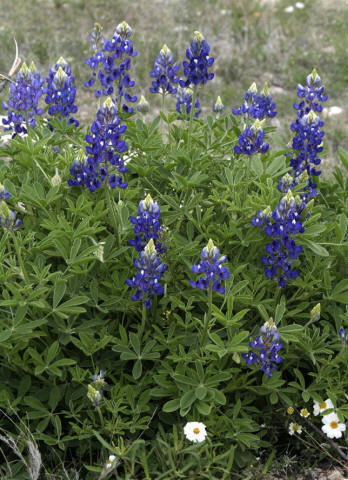 |
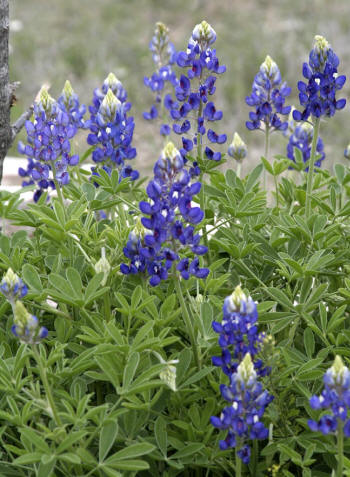 |
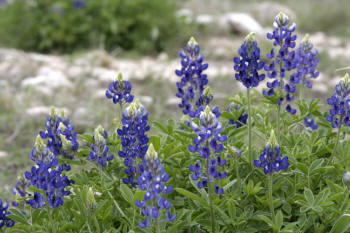 |
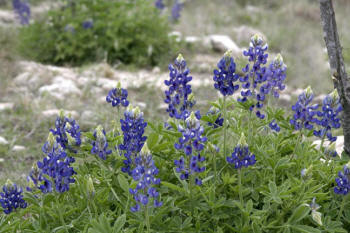 |
![]()
|
Site Copyright © 2003-2018 Son of the South. For questions or comments, contact paul@sonofthesouth.net. |
|
|
|
Are you Scared and Confused? Click Here to read My Snake Story, a story of hope and encouragement, to help you face your fears. |
||
